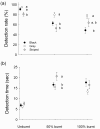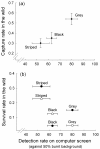Detection experiments with humans implicate visual predation as a driver of colour polymorphism dynamics in pygmy grasshoppers
- PMID: 23639215
- PMCID: PMC3648452
- DOI: 10.1186/1472-6785-13-17
Detection experiments with humans implicate visual predation as a driver of colour polymorphism dynamics in pygmy grasshoppers
Abstract
Background: Animal colour patterns offer good model systems for studies of biodiversity and evolution of local adaptations. An increasingly popular approach to study the role of selection for camouflage for evolutionary trajectories of animal colour patterns is to present images of prey on paper or computer screens to human 'predators'. Yet, few attempts have been made to confirm that rates of detection by humans can predict patterns of selection and evolutionary modifications of prey colour patterns in nature. In this study, we first analyzed encounters between human 'predators' and images of natural black, grey and striped colour morphs of the polymorphic Tetrix subulata pygmy grasshoppers presented on background images of unburnt, intermediate or completely burnt natural habitats. Next, we compared detection rates with estimates of capture probabilities and survival of free-ranging grasshoppers, and with estimates of relative morph frequencies in natural populations.
Results: The proportion of grasshoppers that were detected and time to detection depended on both the colour pattern of the prey and on the type of visual background. Grasshoppers were detected more often and faster on unburnt backgrounds than on 50% and 100% burnt backgrounds. Striped prey were detected less often than grey or black prey on unburnt backgrounds; grey prey were detected more often than black or striped prey on 50% burnt backgrounds; and black prey were detected less often than grey prey on 100% burnt backgrounds. Rates of detection mirrored previously reported rates of capture by humans of free-ranging grasshoppers, as well as morph specific survival in the wild. Rates of detection were also correlated with frequencies of striped, black and grey morphs in samples of T. subulata from natural populations that occupied the three habitat types used for the detection experiment.
Conclusions: Our findings demonstrate that crypsis is background-dependent, and implicate visual predation as an important driver of evolutionary modifications of colour polymorphism in pygmy grasshoppers. Our study provides the clearest evidence to date that using humans as 'predators' in detection experiments may provide reliable information on the protective values of prey colour patterns and of natural selection and microevolution of camouflage in the wild.
Figures





Similar articles
-
Reduced predation risk for melanistic pygmy grasshoppers in post-fire environments.Ecol Evol. 2012 Sep;2(9):2204-12. doi: 10.1002/ece3.338. Epub 2012 Aug 1. Ecol Evol. 2012. PMID: 23139879 Free PMC article.
-
Camouflage effects of various colour-marking morphs against different microhabitat backgrounds in a polymorphic pygmy grasshopper Tetrix japonica.PLoS One. 2010 Jul 6;5(7):e11446. doi: 10.1371/journal.pone.0011446. PLoS One. 2010. PMID: 20625405 Free PMC article.
-
Dynamics of colour polymorphism in a changing environment: fire melanism and then what?Oecologia. 2008 Jan;154(4):715-24. doi: 10.1007/s00442-007-0876-y. Epub 2007 Oct 24. Oecologia. 2008. PMID: 17957385
-
On the role of sex differences for evolution in heterogeneous and changing fitness landscapes: insights from pygmy grasshoppers.Philos Trans R Soc Lond B Biol Sci. 2018 Oct 5;373(1757):20170429. doi: 10.1098/rstb.2017.0429. Philos Trans R Soc Lond B Biol Sci. 2018. PMID: 30150227 Free PMC article. Review.
-
Camouflage in predators.Biol Rev Camb Philos Soc. 2020 Oct;95(5):1325-1340. doi: 10.1111/brv.12612. Epub 2020 May 14. Biol Rev Camb Philos Soc. 2020. PMID: 32410297 Review.
Cited by
-
Common attentional constraints in visual foraging.PLoS One. 2014 Jun 25;9(6):e100752. doi: 10.1371/journal.pone.0100752. eCollection 2014. PLoS One. 2014. PMID: 24964082 Free PMC article.
-
Decoration Increases the Conspicuousness of Raptor Nests.PLoS One. 2016 Jul 25;11(7):e0157440. doi: 10.1371/journal.pone.0157440. eCollection 2016. PLoS One. 2016. PMID: 27455066 Free PMC article.
-
Reassessment of the Phylogenetics of Two Pygmy Grasshopper Generic Groups Tetrix and Systolederus through Mitochondrial Phylogenomics Using Four New Mitochondrial Genome Assemblies.Insects. 2024 Mar 4;15(3):174. doi: 10.3390/insects15030174. Insects. 2024. PMID: 38535370 Free PMC article.
-
Enclosure Background Preferences Differ between Sexes and Color Morphs in the Gouldian Finch.Animals (Basel). 2023 Apr 15;13(8):1353. doi: 10.3390/ani13081353. Animals (Basel). 2023. PMID: 37106916 Free PMC article.
-
Varying benefits of generalist and specialist camouflage in two versus four background environments.Behav Ecol. 2023 Mar 26;34(3):426-436. doi: 10.1093/beheco/arac114. eCollection 2023 May-Jun. Behav Ecol. 2023. PMID: 37192921 Free PMC article.
References
-
- Ruxton GD, Sherratt TN, Speed M. Avoiding attack: the evolutionary ecology of crypsis, warning signals and mimicry. Oxford: Oxford University Press; 2004.
-
- Hoekstra HE, Drumm KE, Nachman MW. Ecological genetics of adaptive color polymorphism in pocket mice: geographic variation in selected and neutral genes. Evolution. 2004;58(6):1329–1341. - PubMed
-
- Forsman A. Opposing fitness consequences of color pattern in male and female snakes. J Evol Biol. 1995;8(1):53–70. doi: 10.1046/j.1420-9101.1995.8010053.x. - DOI
Publication types
MeSH terms
LinkOut - more resources
Full Text Sources
Other Literature Sources

